Choosing the right bicycle is an exciting endeavor, whether you’re a seasoned cyclist upgrading your ride or a beginner purchasing your very first bike. Ensuring the bike frame fits you correctly is paramount for comfort, efficiency, and overall riding enjoyment. Understanding How To Measure A Bike frame is essential not only when you’re considering buying a new or used bike, but also when renting a bicycle, or even when you just want to understand your current bike’s specifications better.
Bike manufacturers don’t always adhere to a uniform sizing system, which can lead to confusion. A size ‘medium’ from one brand might differ significantly from another. To navigate this, focusing on fundamental frame measurements provides a more accurate and consistent approach to bike sizing. By learning how to measure a bike frame yourself, you can confidently compare different bikes and ensure you select one that truly fits your body and riding style.
This guide will walk you through the key bike geometry measurements and provide step-by-step instructions on how to measure them accurately. Whether you’re sizing up a road bike or a mountain bike, understanding these measurements will empower you to make informed decisions and achieve the perfect bike fit. For a deeper dive into how these measurements influence handling, our comprehensive guide to mountain bike geometry offers further insights applicable to both mountain and road bikes. We also offer specific advice on choosing the right size for road bikes and mountain bikes and dedicated guidance for selecting women’s bikes.
Decoding Bike Geometry Measurements
Before we delve into the ‘how-to’ of measuring your bike, let’s familiarize ourselves with the essential geometry measurements that define a bike frame. These measurements dictate how a bike will handle, feel, and fit. Understanding these terms is the first step in learning how to measure a bike effectively.
Here’s a breakdown of the key bike geometry measurements:
- Top Tube Length: This is the horizontal distance between the center of the head tube and the center of the seatpost. It’s a crucial factor in determining the bike’s reach and overall rider position.
- Seat Tube Length: Measured from the center of the bottom bracket to the top of the seat tube, this measurement often dictates frame size, though it can be less consistent across different frame designs.
- Reach: Reach is the horizontal distance from the center of the bottom bracket to the top center of the head tube. It directly impacts how stretched out you’ll be on the bike and is a more consistent sizing metric than top tube length.
- Stack: Stack refers to the vertical distance from the center of the bottom bracket to the top center of the head tube. It determines the handlebar height relative to the bottom bracket and influences rider posture.
- Wheelbase: This is the distance between the front and rear wheel axles. Wheelbase affects the bike’s stability and handling, with a longer wheelbase generally providing more stability.
- Chainstay Length: The distance from the center of the bottom bracket to the rear wheel dropout. Chainstay length influences the bike’s responsiveness and climbing ability. Shorter chainstays often result in a more agile feel.
- Front Center: Measured from the center of the bottom bracket to the front wheel axle. Front center, along with chainstay length, contributes to the wheelbase and affects weight distribution and handling.
- Seat Tube Angle: The angle of the seat tube relative to the ground. This angle impacts your hip angle and pedaling efficiency. Steeper seat tube angles are often favored for climbing and time trialing.
- Head Tube Angle: The angle of the head tube relative to the ground. Head tube angle significantly affects steering responsiveness and stability. Slacker angles are common in mountain bikes for downhill stability, while steeper angles are found in road bikes for quicker handling.
- Bottom Bracket Drop: This is the vertical distance that the bottom bracket sits below the wheel axles. Bottom bracket drop influences the bike’s center of gravity and stability. A lower BB drop generally increases stability.
- Bottom Bracket Height: The distance from the ground to the center of the bottom bracket. Bottom bracket height affects pedal clearance during cornering and can influence stability.
Tools Needed for Bike Frame Measurement
To accurately measure a bike frame, you’ll need a few basic tools. Gathering these beforehand will streamline the process and ensure precise measurements.
Here’s what you’ll need:
- Tape Measure: A standard tape measure is essential for measuring lengths and distances. Metric units (centimeters or millimeters) are recommended for consistency, although some mountain bike manufacturers might still use inches.
- Clinometer (or Smartphone App): A clinometer measures angles accurately. Many free smartphone apps are available that can turn your phone into a clinometer. This is crucial for measuring head tube and seat tube angles.
- Spirit Level (or Straight Edge with Clinometer App): A long spirit level ensures you’re taking horizontal or vertical measurements accurately, especially when measuring top tube length, reach, and stack. Alternatively, you can use a straight piece of wood or metal in conjunction with your clinometer app to ensure level measurements.
- Plumb Line (or String and Weight): A plumb line is a vertical reference. You can create a makeshift plumb line using a piece of string and a small weight like a nut or bolt. Blu Tack can be helpful to secure the string. This is particularly useful for reach and stack measurements.
While geometry charts for current bike models are often available on manufacturer websites and offer precise specifications, knowing how to measure a bike yourself is invaluable, especially for older or used bikes where official data might be unavailable. It also provides a hands-on understanding of your bike’s dimensions.
Step-by-Step Guide: How to Measure Each Bike Frame Dimension
Now, let’s get into the practical steps of measuring your bike frame. Follow these instructions carefully for each measurement to ensure accuracy.
1. Measuring Top Tube Length
 Measuring top tube length on a bike frame
Measuring top tube length on a bike frame
While older bikes often featured horizontal top tubes, modern bike designs frequently incorporate sloping top tubes. When discussing top tube length in geometry charts, manufacturers usually refer to the effective or virtual top tube length. This measurement provides a standardized way to compare bikes regardless of top tube slope.
To measure the effective top tube length:
- Identify Measurement Points: Locate the center of your head tube and imagine the center of your seat post (if the seat post is not directly in line, visualize where its center would be horizontally from the head tube).
- Ensure Horizontal Measurement: Use your spirit level (or straight edge with clinometer app) to ensure your tape measure is perfectly horizontal between these two points.
- Measure the Distance: Measure the horizontal distance from the center of the head tube to the center of the seat post. This is your effective top tube length.
Road bikes are often sized based on top tube length, although this is becoming less common in favor of reach and stack. Mountain bikes and some modern road bikes often use S, M, L, XL sizing, but even within these categories, top tube length variations exist between brands. For example, a size S frame from one brand might have a significantly different top tube length than a size S from another. Notably, brands may also use slightly different methods to calculate virtual top tube length, so direct comparison requires careful attention to measurement methodologies.
2. Measuring Seat Tube Length
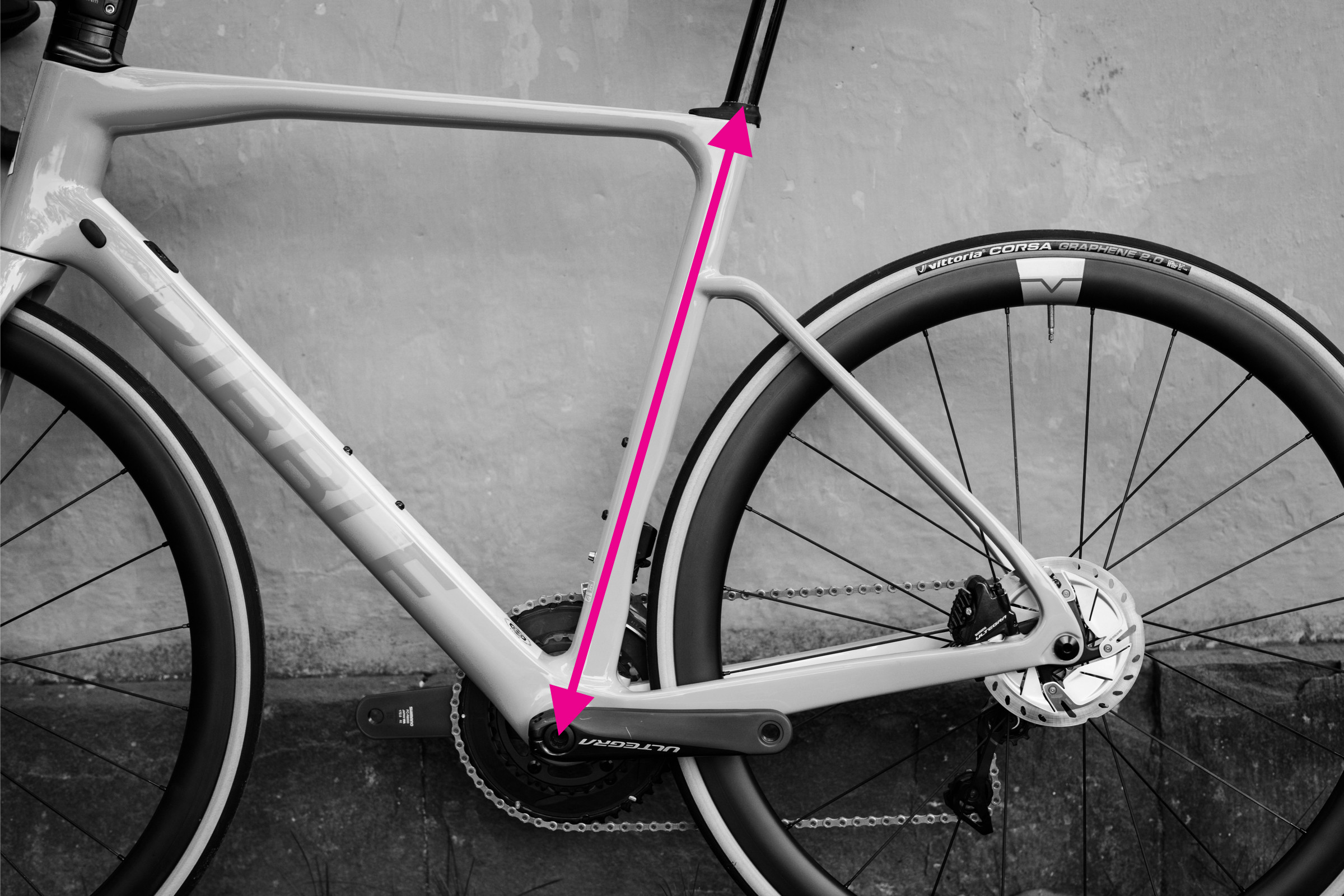 Measuring seat tube length on a bicycle frame
Measuring seat tube length on a bicycle frame
Seat tube length is measured as a straight line from the center of the bottom bracket to the top of the seat tube. However, frame designs can complicate this measurement:
- Identify Measurement Points: Locate the center of the bottom bracket and the top of the seat tube.
- Account for Design Variations: Be aware that some bikes, especially certain road bike models, may have seat tubes that extend significantly above the top tube junction or utilize a seat mast. Mountain bikes often have kinks or bends in the seat tube.
- Straight Line Measurement: Use a straight edge to visualize a direct line between the bottom bracket center and the top of the seat tube, bypassing any bends or extensions in the actual seat tube.
- Measure the Distance: Measure along this straight line from the bottom bracket center to the top of the seat tube. This is your seat tube length.
Avoid following the contour of the seat tube itself if it’s curved or kinked, as this will result in an inaccurate, longer measurement.
3. Measuring Reach and Stack
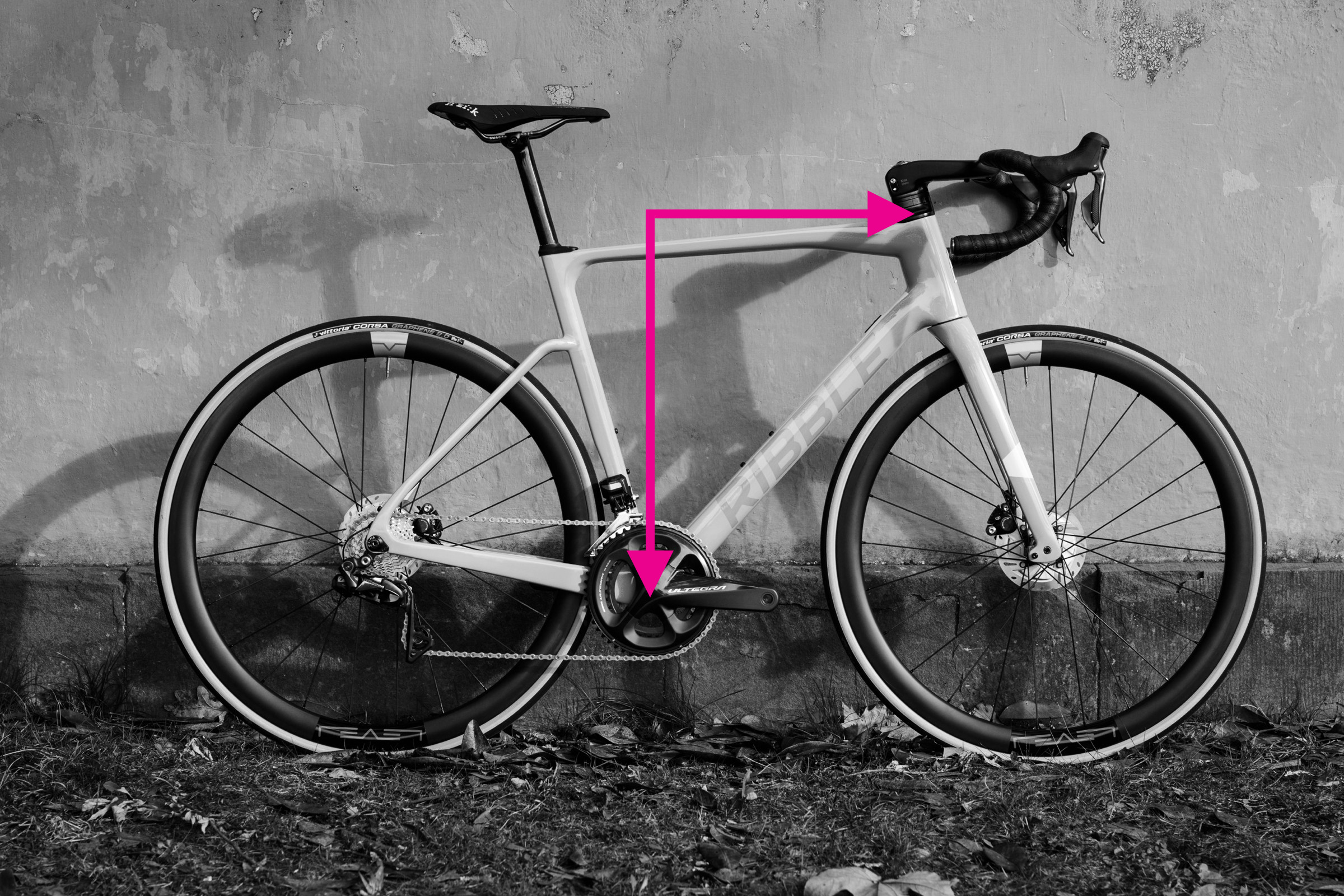 Measuring stack and reach on a bike frame
Measuring stack and reach on a bike frame
Reach and stack are increasingly favored by bike manufacturers as they offer more consistent and design-independent sizing metrics compared to top tube and seat tube lengths. They represent the perpendicular distances between the bottom bracket and the top of the head tube, two critical contact points on the bike.
To measure reach and stack:
Reach (Horizontal Distance):
- Set Up Plumb Line: Attach a plumb line to one end of your spirit level.
- Align Spirit Level: Position the spirit level so its top edge aligns with the top center of the head tube.
- Find Bottom Bracket Intersection: Adjust the level until the plumb line hangs directly over the center of the bottom bracket spindle.
- Measure Reach: Measure the horizontal distance from the top of the plumb line to the center of the head tube. This is your reach.
Stack (Vertical Distance):
- Maintain Plumb Line Setup: Keep the spirit level and plumb line in the same position used for the reach measurement.
- Measure Stack: Measure the vertical distance along the plumb line from the spirit level (aligned with the top of the head tube) down to the center of the bottom bracket. This is your stack.
Alternatively, for stack, you can measure the vertical distance from the ground to the top of the head tube and then subtract the vertical distance from the ground to the bottom bracket. Reach and stack measurements can be tricky to get perfectly accurate, especially when using a plumb line alone. Having a second person assist can be helpful, and repeating the measurements a few times can improve consistency.
4. Measuring Wheelbase
 Measuring wheelbase on a bike frame
Measuring wheelbase on a bike frame
Wheelbase, the distance between the front and rear axles, is a key determinant of a bike’s ride quality and handling characteristics.
To measure wheelbase:
- Straighten Fork: Ensure your front fork is pointing straight ahead.
- Identify Axle Centers: Locate the center points of your front and rear wheel axles.
- Measure Distance: Measure the straight-line distance between the front and rear axle centers. This is your wheelbase.
For increased accuracy, especially if you suspect your fork might not be perfectly straight, measure the wheelbase on both sides of the bike and calculate the average of the two measurements.
5. Measuring Chainstay Length
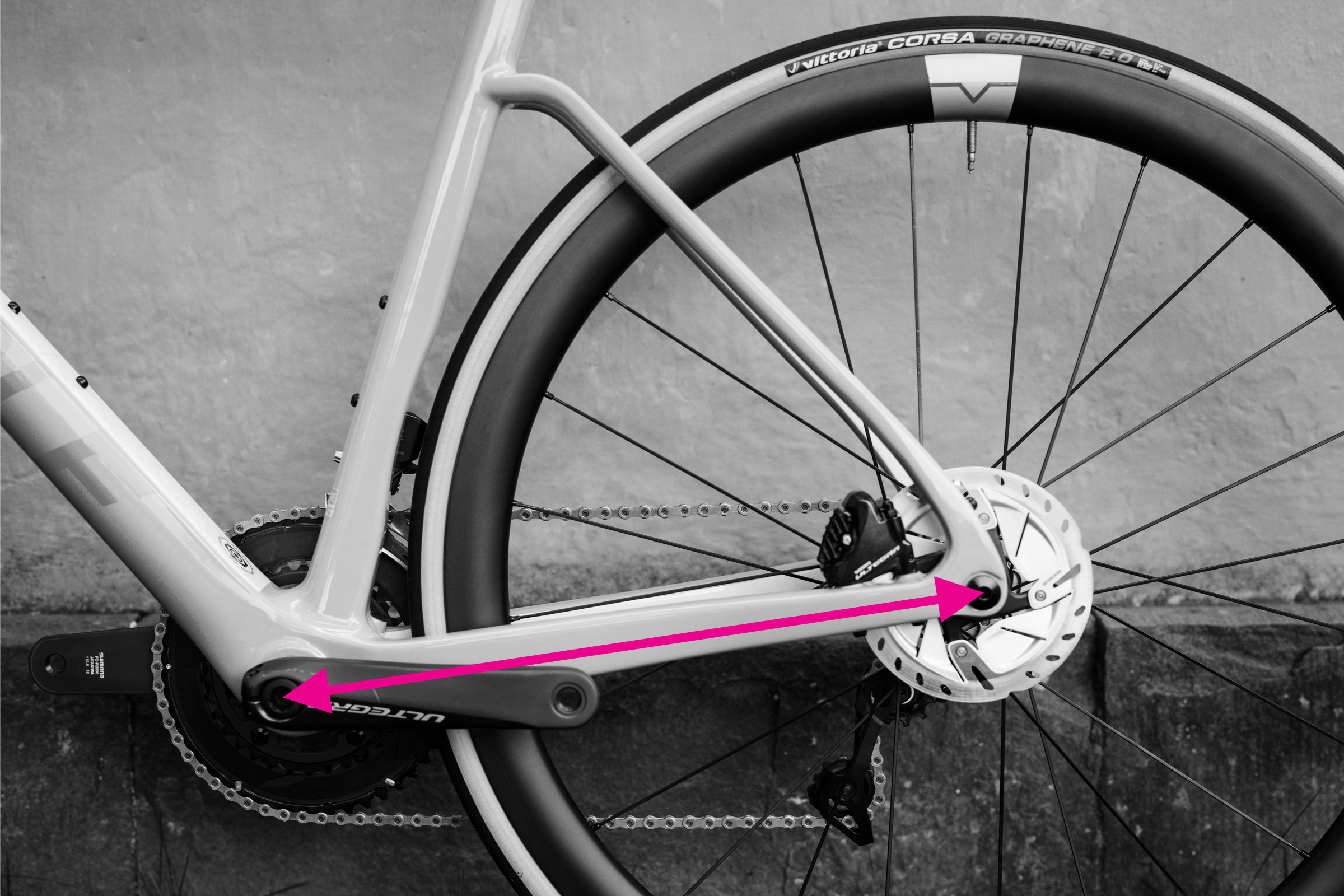 Measuring chainstay length on a bike frame
Measuring chainstay length on a bike frame
Chainstay length is a component of the wheelbase and significantly influences a bike’s handling, particularly its responsiveness and agility.
To measure chainstay length:
- Identify Measurement Points: Locate the center of the bottom bracket axle and the center of the rear dropout slot.
- Measure Distance: Measure the straight-line distance between the bottom bracket center and the rear dropout center. This is your chainstay length.
Shorter chainstays generally contribute to a more lively and nimble feel, while longer chainstays can offer more stability.
6. Measuring Front Center
 Measuring front center on a bike frame
Measuring front center on a bike frame
Front center is the other component that, along with chainstay length, makes up the wheelbase. It’s measured from the bottom bracket to the front axle.
To measure front center:
- Identify Measurement Points: Locate the center of the bottom bracket axle and the center of the front dropout slot.
- Measure Distance: Measure the straight-line distance between the bottom bracket center and the front dropout center. This is your front center.
While front center is not always provided in bike geometry charts, it influences handling and toe overlap (the possibility of your shoe hitting the front wheel during sharp turns). Note that wheelbase is not simply the sum of chainstay length and front center, as these measurements are not taken along a horizontal plane.
7. Measuring Seat Tube and Head Tube Angles
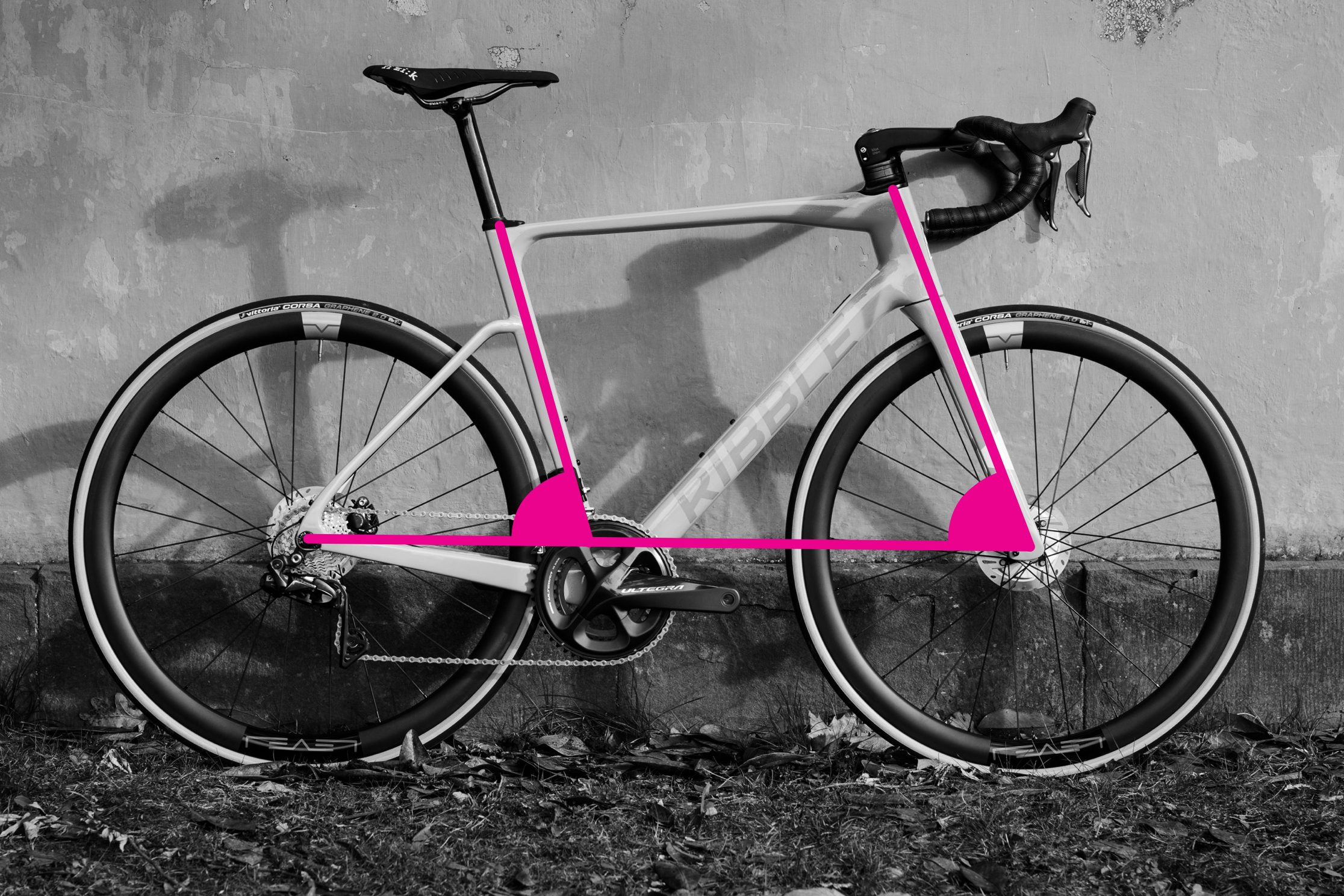 Measuring seat tube and head tube angles on a bike frame
Measuring seat tube and head tube angles on a bike frame
Seat tube and head tube angles are crucial for determining a bike’s handling characteristics. Steeper angles generally result in quicker, more nimble handling.
Seat Tube Angle:
- Vertical Bike: Ensure your bike is standing vertically on level ground.
- Align Clinometer: Place your smartphone (running a clinometer app) directly against the seat tube. If your seat tube is not straight due to a bend or kink, use a straight edge aligned with the main section of the seat tube and place your phone against the straight edge.
- Read Angle: Read the angle measurement from your clinometer app. This is your seat tube angle.
Head Tube Angle:
- Vertical Bike: Ensure your bike is standing vertically on level ground.
- Align Clinometer: Place your smartphone (with clinometer app) against the head tube. For tapered head tubes, try to align your phone with the center line of the head tube or use a straight edge connecting the top and bottom centers of the head tube. Alternatively, if your fork legs are straight, you can measure the angle of the fork legs as it will closely correspond to the head tube angle. You can also measure against the steerer tube extension above the head tube.
- Read Angle: Read the angle from your clinometer app. This is your head tube angle.
Ensure the bike is perfectly vertical for accurate angle measurements.
8. Measuring Bottom Bracket Drop
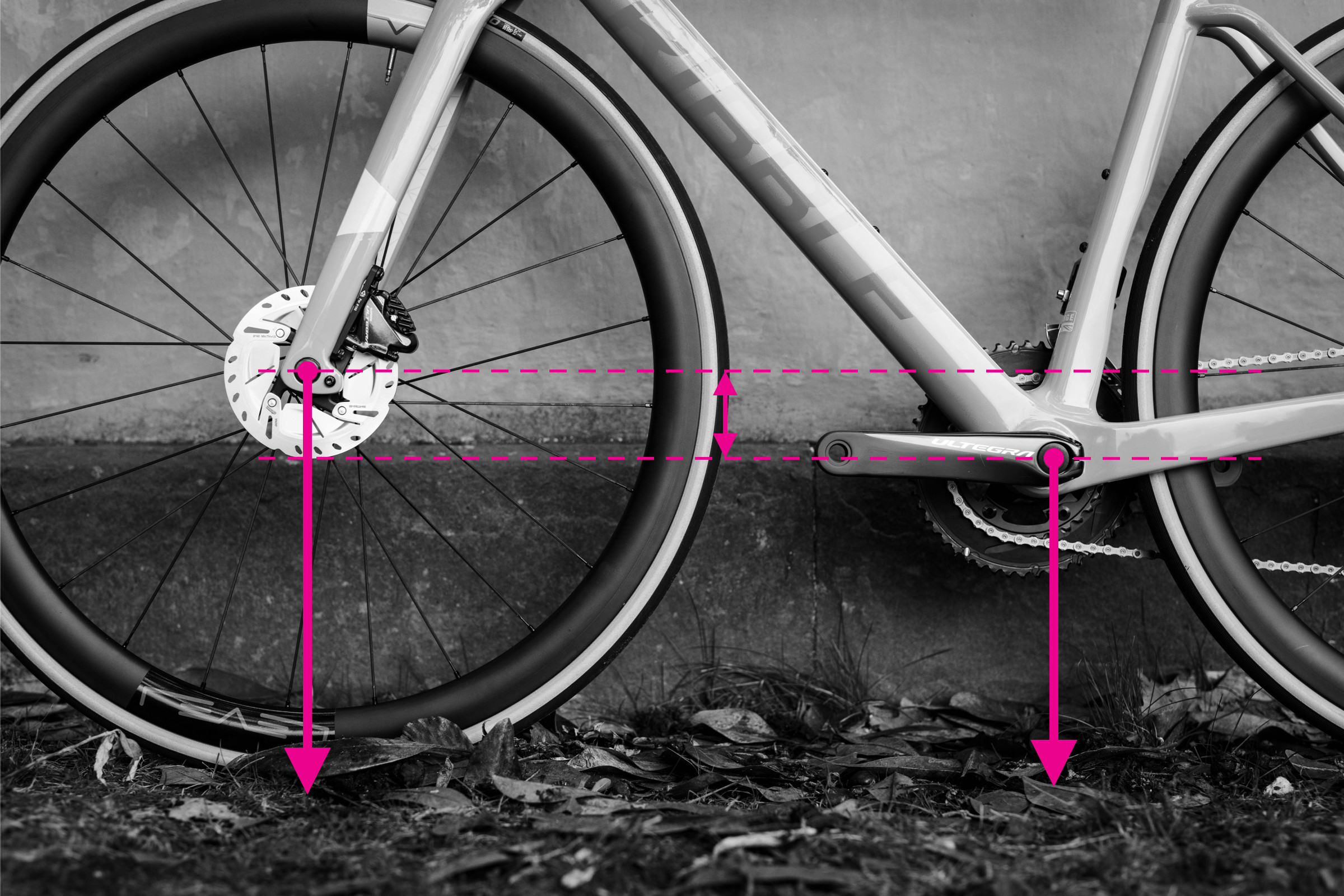 Measuring bottom bracket drop on a bike frame
Measuring bottom bracket drop on a bike frame
Bottom bracket drop is the vertical distance the bottom bracket sits below the wheel axles. It influences the bike’s center of gravity and stability.
To measure bottom bracket drop:
- Measure Rear Axle Height: Measure the vertical distance from the ground to the center of the rear wheel axle.
- Measure Bottom Bracket Height: Measure the vertical distance from the ground to the center of the bottom bracket.
- Calculate Drop: Subtract the bottom bracket height from the rear axle height. This difference is your bottom bracket drop.
9. Measuring Bottom Bracket Height
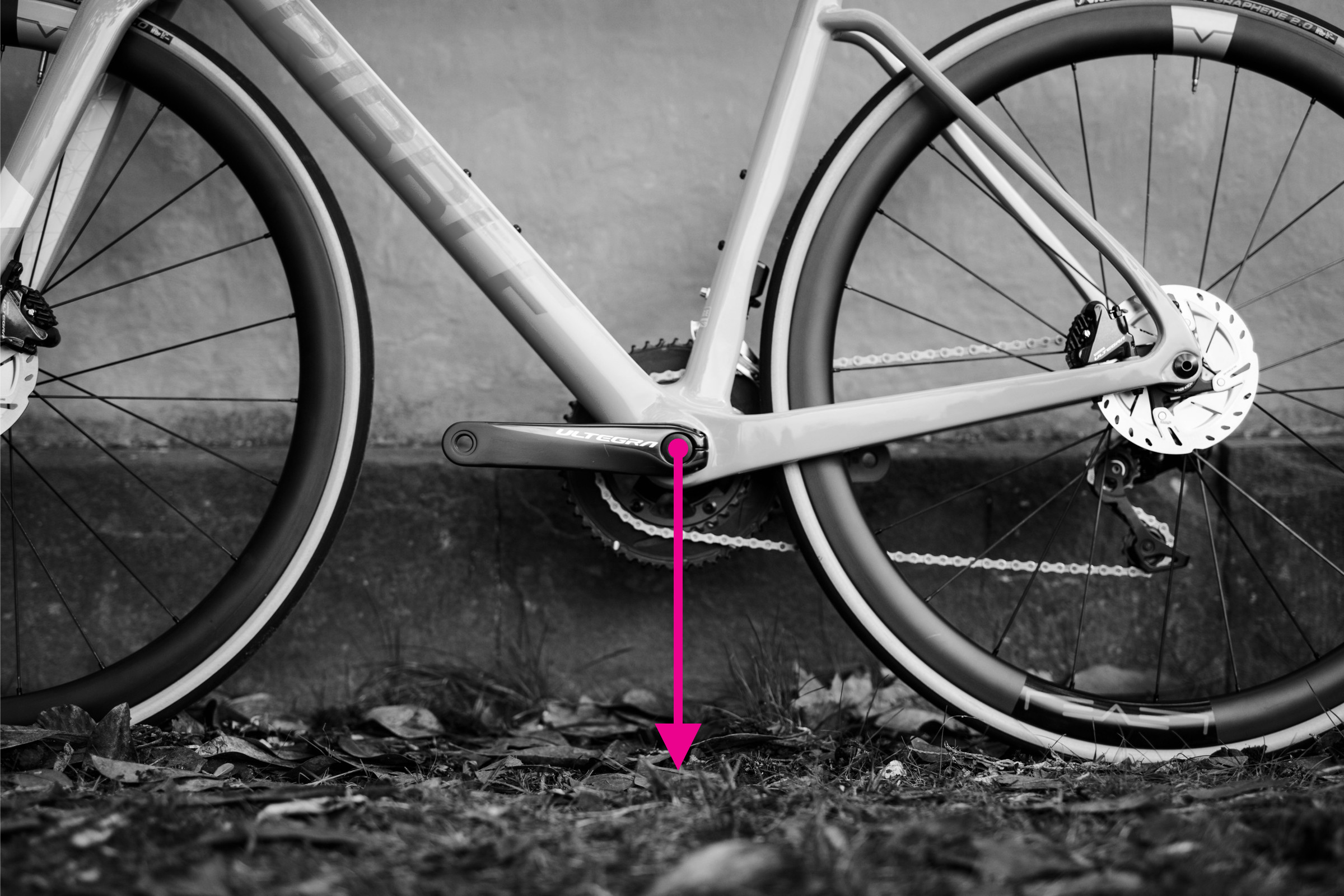 Measuring bottom bracket height on a bike frame
Measuring bottom bracket height on a bike frame
Bottom bracket height is simply the distance from the ground to the center of the bottom bracket. It affects pedal clearance and, to a lesser degree, stability.
To measure bottom bracket height:
- Vertical Bike & Tire Pressure: Ensure your bike is standing upright and your tires are inflated to your typical riding pressure, as tire pressure slightly affects this measurement.
- Measure Height: Measure the vertical distance from the ground to the center of the bottom bracket. This is your bottom bracket height.
Conclusion: Your Bike Measurement Toolkit
By mastering how to measure a bike frame, you gain valuable insights into your current bike’s geometry and equip yourself with the knowledge to make informed decisions when purchasing a new or used bicycle. These measurements empower you to compare bikes effectively, understand their handling characteristics, and ultimately choose a bike that fits you perfectly and suits your riding style.
Keep your recorded measurements in a safe place. This data will be a valuable resource for future bike purchases, whether you’re looking for a new road bike, a second-hand bike, a practical commuting bike, or an adventurous gravel bike. Accurate bike measurements are a cyclist’s best friend when it comes to achieving optimal fit and performance.
